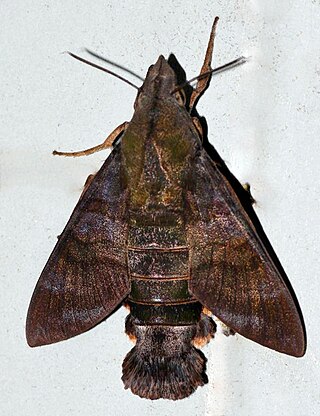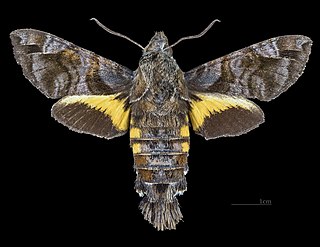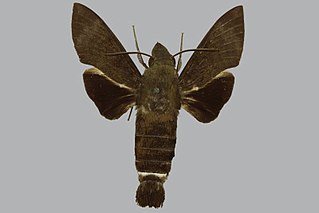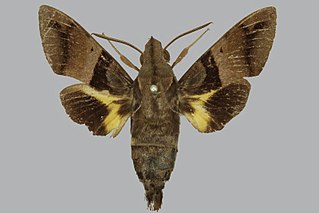
The hummingbird hawk-moth is a species of hawk moth found across temperate regions of Eurasia. The species is named for its similarity to hummingbirds, as they feed on the nectar of tube-shaped flowers using their long proboscis while hovering in the air; this resemblance is an example of convergent evolution.

Macroglossum alcedo is a moth of the family Sphingidae. It is known from Tanimbar, the Kai Islands, Aru, Papua New Guinea and Queensland.

Macroglossum albolineata is a moth of the family Sphingidae. It was described by Benjamin Preston Clark in 1935 and is known from Papua New Guinea.

Macroglossum augarra is a moth of the family Sphingidae. It is known from the Bismarck Archipelago and Papua New Guinea.

Macroglossum caldum is a moth of the family Sphingidae. It is known from Papua New Guinea and the Philippines.

Macroglossum corythus is a species of hawk moth of the family Sphingidae. It was described by Francis Walker in 1856 and is found throughout the Indo-Australian tropics east to New Caledonia.

Macroglossum dohertyi is a moth of the family Sphingidae. It is known from Queensland and Papua New Guinea.

Macroglossum glaucoptera, the dark hummingbird hawkmoth, is a moth of the family Sphingidae. It was described by Arthur Gardiner Butler in 1875. It is known from Sri Lanka, Thailand, southern China, Vietnam, Malaysia (Peninsular), Indonesia and the Philippines (Mindanao). Single specimen recorded from Papua New Guinea.

Macroglossum hirundo is a moth of the family Sphingidae. It is known from the Cook Islands, Fiji, the Society Islands, Australia, Papua New Guinea, the Bismarck Archipelago and the Solomon Islands.

Macroglossum insipida, the hermit hummingbird hawkmoth, is a moth of the family Sphingidae. It was described by Arthur Gardiner Butler in 1875.

Macroglossum meeki is a moth of the family Sphingidae. It is known from Papua New Guinea.

Macroglossum melas is a moth of the family Sphingidae. It is known from Indonesia, Papua New Guinea and the Solomon Islands.

Macroglossum micacea is a moth of the family Sphingidae. It is known from the Solomon Islands, the D'Entrecasteaux Islands, Papua New Guinea and Queensland.

Macroglossum nubilum is a moth of the family Sphingidae. It is known to inhabit Queensland, Papua New Guinea and the Louisiade Archipelago.

Macroglossum spilonotum is a moth of the family Sphingidae. It is known from Papua New Guinea.

Macroglossum stevensi is a moth of the family Sphingidae. It is known from Papua New Guinea.

Macroglossum stigma is a moth of the family Sphingidae. It is known from Papua New Guinea.

Macroglossum tenebrosa is a moth of the family Sphingidae first described by Thomas Pennington Lucas in 1891. It is known from Sulawesi, the Moluccas, Aru, Papua New Guinea, the Bismarck Archipelago, the Solomon Islands and north-eastern Australia.

Macroglossum vidua is a moth of the family Sphingidae. It is known from north-eastern Papua New Guinea.

Macroglossum is a genus of moths in the family Sphingidae. The genus was erected by Giovanni Antonio Scopoli in 1777.



















